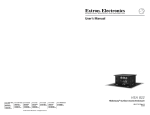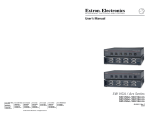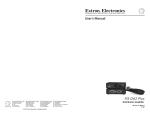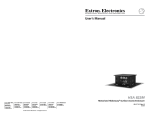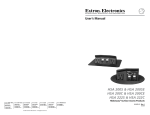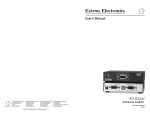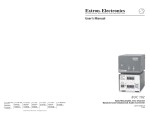Download Extron electronics PA 300 User`s manual
Transcript
User’s Manual PA 300 Peaking Amplifier 68-1108-01 B 12 08 Precautions Safety Instructions • English This symbol is intended to alert the user of important operating and maintenance (servicing) instructions in the literature provided with the equipment. This symbol is intended to alert the user of the presence of uninsulated dangerous voltage within the product’s enclosure that may present a risk of electric shock. Caution Read Instructions • Read and understand all safety and operating instructions before using the equipment. Retain Instructions • The safety instructions should be kept for future reference. Follow Warnings • Follow all warnings and instructions marked on the equipment or in the user information. Avoid Attachments • Do not use tools or attachments that are not recommended by the equipment manufacturer because they may be hazardous. Consignes de Sécurité • Français Ce symbole sert à avertir l’utilisateur que la documentation fournie avec le matériel contient des instructions importantes concernant l’exploitation et la maintenance (réparation). Ce symbole sert à avertir l’utilisateur de la présence dans le boîtier de l’appareil de tensions dangereuses non isolées posant des risques d’électrocution. Attention Lire les instructions• Prendre connaissance de toutes les consignes de sécurité et d’exploitation avant d’utiliser le matériel. Conserver les instructions• Ranger les consignes de sécurité afin de pouvoir les consulter à l’avenir. Respecter les avertissements • Observer tous les avertissements et consignes marqués sur le matériel ou présentés dans la documentation utilisateur. Eviter les pièces de fixation • Ne pas utiliser de pièces de fixation ni d’outils non recommandés par le fabricant du matériel car cela risquerait de poser certains dangers. Sicherheitsanleitungen • Deutsch Dieses Symbol soll dem Benutzer in der im Lieferumfang enthaltenen Dokumentation besonders wichtige Hinweise zur Bedienung und Wartung (Instandhaltung) geben. Dieses Symbol soll den Benutzer darauf aufmerksam machen, daß im Inneren des Gehäuses dieses Produktes gefährliche Spannungen, die nicht isoliert sind und die einen elektrischen Schock verursachen können, herrschen. Achtung Lesen der Anleitungen • Bevor Sie das Gerät zum ersten Mal verwenden, sollten Sie alle Sicherheits-und Bedienungsanleitungen genau durchlesen und verstehen. Aufbewahren der Anleitungen • Die Hinweise zur elektrischen Sicherheit des Produktes sollten Sie aufbewahren, damit Sie im Bedarfsfall darauf zurückgreifen können. Befolgen der Warnhinweise • Befolgen Sie alle Warnhinweise und Anleitungen auf dem Gerät oder in der Benutzerdokumentation. Keine Zusatzgeräte • Verwenden Sie keine Werkzeuge oder Zusatzgeräte, die nicht ausdrücklich vom Hersteller empfohlen wurden, da diese eine Gefahrenquelle darstellen können. Instrucciones de seguridad • Español Este símbolo se utiliza para advertir al usuario sobre instrucciones importantes de operación y mantenimiento (o cambio de partes) que se desean destacar en el contenido de la documentación suministrada con los equipos. Este símbolo se utiliza para advertir al usuario sobre la presencia de elementos con voltaje peligroso sin protección aislante, que puedan encontrarse dentro de la caja o alojamiento del producto, y que puedan representar riesgo de electrocución. Precaucion Leer las instrucciones • Leer y analizar todas las instrucciones de operación y seguridad, antes de usar el equipo. Conservar las instrucciones • Conservar las instrucciones de seguridad para futura consulta. Obedecer las advertencias • Todas las advertencias e instrucciones marcadas en el equipo o en la documentación del usuario, deben ser obedecidas. Evitar el uso de accesorios • No usar herramientas o accesorios que no sean especificamente recomendados por el fabricante, ya que podrian implicar riesgos. Warning Power sources • This equipment should be operated only from the power source indicated on the product. This equipment is intended to be used with a main power system with a grounded (neutral) conductor. The third (grounding) pin is a safety feature, do not attempt to bypass or disable it. Power disconnection • To remove power from the equipment safely, remove all power cords from the rear of the equipment, or the desktop power module (if detachable), or from the power source receptacle (wall plug). Power cord protection • Power cords should be routed so that they are not likely to be stepped on or pinched by items placed upon or against them. Servicing • Refer all servicing to qualified service personnel. There are no userserviceable parts inside. To prevent the risk of shock, do not attempt to service this equipment yourself because opening or removing covers may expose you to dangerous voltage or other hazards. Slots and openings • If the equipment has slots or holes in the enclosure, these are provided to prevent overheating of sensitive components inside. These openings must never be blocked by other objects. Lithium battery • There is a danger of explosion if battery is incorrectly replaced. Replace it only with the same or equivalent type recommended by the manufacturer. Dispose of used batteries according to the manufacturer’s instructions. Avertissement Alimentations• Ne faire fonctionner ce matériel qu’avec la source d’alimentation indiquée sur l’appareil. Ce matériel doit être utilisé avec une alimentation principale comportant un fil de terre (neutre). Le troisième contact (de mise à la terre) constitue un dispositif de sécurité : n’essayez pas de la contourner ni de la désactiver. Déconnexion de l’alimentation• Pour mettre le matériel hors tension sans danger, déconnectez tous les cordons d’alimentation de l’arrière de l’appareil ou du module d’alimentation de bureau (s’il est amovible) ou encore de la prise secteur. Protection du cordon d’alimentation • Acheminer les cordons d’alimentation de manière à ce que personne ne risque de marcher dessus et à ce qu’ils ne soient pas écrasés ou pincés par des objets. Réparation-maintenance • Faire exécuter toutes les interventions de réparationmaintenance par un technicien qualifié. Aucun des éléments internes ne peut être réparé par l’utilisateur. Afin d’éviter tout danger d’électrocution, l’utilisateur ne doit pas essayer de procéder lui-même à ces opérations car l’ouverture ou le retrait des couvercles risquent de l’exposer à de hautes tensions et autres dangers. Fentes et orifices • Si le boîtier de l’appareil comporte des fentes ou des orifices, ceux-ci servent à empêcher les composants internes sensibles de surchauffer. Ces ouvertures ne doivent jamais être bloquées par des objets. Lithium Batterie • Il a danger d’explosion s’ll y a remplacment incorrect de la batterie. Remplacer uniquement avec une batterie du meme type ou d’un ype equivalent recommande par le constructeur. Mettre au reut les batteries usagees conformement aux instructions du fabricant. Vorsicht Stromquellen • Dieses Gerät sollte nur über die auf dem Produkt angegebene Stromquelle betrieben werden. Dieses Gerät wurde für eine Verwendung mit einer Hauptstromleitung mit einem geerdeten (neutralen) Leiter konzipiert. Der dritte Kontakt ist für einen Erdanschluß, und stellt eine Sicherheitsfunktion dar. Diese sollte nicht umgangen oder außer Betrieb gesetzt werden. Stromunterbrechung • Um das Gerät auf sichere Weise vom Netz zu trennen, sollten Sie alle Netzkabel aus der Rückseite des Gerätes, aus der externen Stomversorgung (falls dies möglich ist) oder aus der Wandsteckdose ziehen. Schutz des Netzkabels • Netzkabel sollten stets so verlegt werden, daß sie nicht im Weg liegen und niemand darauf treten kann oder Objekte darauf- oder unmittelbar dagegengestellt werden können. Wartung • Alle Wartungsmaßnahmen sollten nur von qualifiziertem Servicepersonal durchgeführt werden. Die internen Komponenten des Gerätes sind wartungsfrei. Zur Vermeidung eines elektrischen Schocks versuchen Sie in keinem Fall, dieses Gerät selbst öffnen, da beim Entfernen der Abdeckungen die Gefahr eines elektrischen Schlags und/oder andere Gefahren bestehen. Schlitze und Öffnungen • Wenn das Gerät Schlitze oder Löcher im Gehäuse aufweist, dienen diese zur Vermeidung einer Überhitzung der empfindlichen Teile im Inneren. Diese Öffnungen dürfen niemals von anderen Objekten blockiert werden. Litium-Batterie • Explosionsgefahr, falls die Batterie nicht richtig ersetzt wird. Ersetzen Sie verbrauchte Batterien nur durch den gleichen oder einen vergleichbaren Batterietyp, der auch vom Hersteller empfohlen wird. Entsorgen Sie verbrauchte Batterien bitte gemäß den Herstelleranweisungen. Advertencia Alimentación eléctrica • Este equipo debe conectarse únicamente a la fuente/tipo de alimentación eléctrica indicada en el mismo. La alimentación eléctrica de este equipo debe provenir de un sistema de distribución general con conductor neutro a tierra. La tercera pata (puesta a tierra) es una medida de seguridad, no puentearia ni eliminaria. Desconexión de alimentación eléctrica • Para desconectar con seguridad la acometida de alimentación eléctrica al equipo, desenchufar todos los cables de alimentación en el panel trasero del equipo, o desenchufar el módulo de alimentación (si fuera independiente), o desenchufar el cable del receptáculo de la pared. Protección del cables de alimentación • Los cables de alimentación eléctrica se deben instalar en lugares donde no sean pisados ni apretados por objetos que se puedan apoyar sobre ellos. Reparaciones/mantenimiento • Solicitar siempre los servicios técnicos de personal calificado. En el interior no hay partes a las que el usuario deba acceder. Para evitar riesgo de electrocución, no intentar personalmente la reparación/mantenimiento de este equipo, ya que al abrir o extraer las tapas puede quedar expuesto a voltajes peligrosos u otros riesgos. Ranuras y aberturas • Si el equipo posee ranuras o orificios en su caja/alojamiento, es para evitar el sobrecalientamiento de componentes internos sensibles. Estas aberturas nunca se deben obstruir con otros objetos. Batería de litio • Existe riesgo de explosión si esta batería se coloca en la posición incorrecta. Cambiar esta batería únicamente con el mismo tipo (o su equivalente) recomendado por el fabricante. Desachar las baterías usadas siguiendo las instrucciones del fabricante. ᅝܼ乏ⶹ•Ё᭛ 䄺ਞ 䖭Ͼヺোᦤ⼎⫼᠋䆹䆒⫼᠋ݠЁ ᳝䞡㽕ⱘ᪡㓈ᡸ䇈ᯢDŽ ⬉⑤• 嬦 嫿 ⡈ ⌫ 倾 Ề 䑩 ᷨ ␂ ᵋ 㝈 㕏 䗅 䑶 㷑 ɿ 嫿 ⡈ ⼆枼Ề䑩㙊♱一䗅Ờ䑶䰼丠Ờ䑶ɿ䩭ᵊ㚢一 澠♱一澡㕰⫊₩嫿㓾澤ᵎ倾ᵎ䑩ㅗ崴弈ɿ 䖭Ͼヺো䄺ਞ⫼᠋䆹䆒ᴎݙ᳝ᲈ ᢨᥝ⬉⑤• ᵻ⫊₩♱ḏ嫿⡈㈕㋊䑶㷑澤嬸㈕㋊ㆁ㙊嫿⡈⍏ ㅗ㞍暣䑶㷑䗅䑶㷑一澤ㅗḼẖ㋦ⅱⵃ䑶䰼丠䗅䑶㷑一ɿ 䴆ⱘॅ䰽⬉य़ˈ᳝㾺⬉ॅ䰽DŽ ⬉⑤㒓ֱᡸ• ⣦Ⓟⵄ一澤忀₎埬嵪嵐澤ㅗ愎䆪㉥⋌ɿ ⊼ᛣ 䯙䇏䇈ᯢк• 䑩 ㅸ Ề 䑩 嬦 嫿 ⡈ ⼆ 枼 敆 嬼 䍇 夤ㆁ㙊⫊₩⏍Ề䑩嬵㕏ɿ ֱᄬ䇈ᯢк• 䑩ㅸⷕ⪙⫊₩嬵㕏ᶧḦ⡈⭇㚦Ề 䑩ɿ 䙉ᅜ䄺ਞ• 䑩ㅸⷕ徶⫉ᷨ␂⏍䑩ㅸ㉈⊘ᵋ䗅ㆁ㙊⫊ ₩⏍㐎ẝ嬵㕏ɿ 㓈ᡸ•ㆁ㙊丵Ἧ⼆枼䑲嫥嬂䗅丵Ἧ᷻⎙弜垍ɿ嫿⡈怩㯢 㙊䑩ㅸ⌰Ḧ㘵㊣䗅昷ḷɿᵻ忀₎℻䋱大䑶⊲斪ᵎ壂儫ⴲ 嬖☿㆔⹁嫿⡈䘗⪑丵Ἧ嬦嫿⡈ɿ 䗮亢ᄨ• 㙊ᷜ嫿⡈㙻⠴ᵋ㙊彛栏㤾ㅗ⪕澤⫄ḭ㕰䑩㚦敳㪣 㙻㒐だ₄ḷ弈䀮ɿᵎ壂䑩Ḽẖᵝ壀㉢Ẑ彛栏⪕ɿ 䫖⬉∴• ᵎ㪤䞯䗅㘵㊣䑶㮡ṛ㙊䅇㿹䗅⊲斪ɿ⼆枼Ề䑩ᵏ ⋃⫷㋩劑䗅䘹⍍ㅗ䘹弒⛌⌸䗅䑶㮡ɿ㉊䂨䑠ᷨ⋃䗅⸻ 嫯⡅䍇ⷠ⹄䑶㮡ɿ 䙓ܡ䗑ࡴ• ᵎ壂Ề䑩嬦ᷨ␂⋃⒇㯢㙊㋩劑䗅₸ㅗ 弾⇡嫿⡈澤Ḧ忀₎⊲斪ɿ FCC Class A Notice This equipment has been tested and found to comply with the limits for a Class A digital device, pursuant to part 15 of the FCC Rules. Operation is subject to the following two conditions: (1) this device may not cause harmful interference, and (2) this device must accept any interference received, including interference that may cause undesired operation. The Class A limits are designed to provide reasonable protection against harmful interference when the equipment is operated in a commercial environment. This equipment generates, uses, and can radiate radio frequency energy and, if not installed and used in accordance with the instruction manual, may cause harmful interference to radio communications. Operation of this equipment in a residential area is likely to cause harmful interference, in which case the user will be required to correct the interference at his own expense. N This unit was tested with shielded cables on the peripheral devices. Shielded cables must be used with the unit to ensure compliance with FCC emissions limits. Table of Contents Chapter One • Introduction ................................................... 1-1 About this Manual..................................................................... 1-2 About the PA 300. ...................................................................... 1-2 Features......................................................................................... 1-2 Chapter Two • Installation and Operation .................. 2-1 Installation Overview. .............................................................. 2-2 Mounting the PA 300................................................................ 2-2 Tabletop use............................................................................ 2-3 Rack mounting........................................................................ 2-3 Under-desk mounting............................................................. 2-4 Through-desk mounting......................................................... 2-6 Front Panel Features.................................................................. 2-7 Rear Panel Features................................................................... 2-7 Cabling........................................................................................... 2-8 Chapter Three • Adjusting the Display .......................... 3-1 Signal Compatibility.................................................................. 3-2 Potentiometer Adjustments................................................... 3-2 Adjusting gain with an oscilloscope...................................... 3-2 Adjusting gain without an oscilloscope................................ 3-2 Adjusting the peaking ........................................................... 3-3 Appendix A • Specifications, Part Numbers, and Accessories .........................................................................................A-1 Specifications...............................................................................A-2 Parts................................................................................................A-5 Included parts.........................................................................A-5 Optional accessories...............................................................A-5 Cables......................................................................................A-5 PA 300 Peaking Amplifier • Table of Contents i Table of Contents, cont’d All trademarks mentioned in this manual are the properties of their respective owners. 68-1108-01 B 12 08 ii PA 300 Peaking Amplifier • Table of Contents PA 300 1 Chapter One Introduction About this Manual About the PA 300 Features Introduction About this Manual This manual contains information about the Extron PA 300 peaking amplifier, and includes information on how to install, operate and troubleshoot the unit. About the PA 300 The PA 300 is an ultra high performance RGB peaking amplifier capable of driving a 1600 x 1200 resolution computer signal over 600 feet (185 m) using Extron Mini HR cables, or 1000 feet (300 m) using Extron RG6 cable. The PA 300 is compatible with both RGB and HDTV component signals. The PA 300 has one gain potentiometer and two peaking potentiometers on the front panel. On the rear panel, the PA 300 provides five BNCs for RGBHV input and five BNCs for RGBHV output. The unit restores the sync signals, but does not process them for format, polarity, or delay. The PA 300 is housed in a 1U, half rack, 6" (15.2 cm) deep, 2-piece enclosure, and uses an internal power supply. Features Bandwidth — 350 MHz (-3 dB) RGB video bandwidth, fully loaded. Gain and peaking control — allows optimized output compensation for various cable lengths and applications. Light and compact metal enclosure — 1U, half rack, 6" (15.2 cm) deep, 2-piece enclosure. Versatile mounting options — can be set on a table; mounted on a rack shelf; or mounted through or under a desk, podium, or tabletop. Global accessibility — has a universal internal power supply that allows for worldwide usability. 1-2 PA 300 Peaking Amplifier • Introduction PA 300 2 Chapter Two Installation and Operation Installation Overview Mounting the PA 300 Front Panel Features Rear Panel Features Cabling Installation and Operation Installation Overview 1 Be certain the source device, the PA 300, and the output device are turned off and disconnected from the power source. 2 If desired, mount the PA 300 in a rack or furniture. See "Mounting the PA 300", below. 3 Cable the inputs and outputs to the PA 300. See "Cabling" on page 2-8. 4 Plug the input device, the PA 300, and the output device into a grounded AC source. 5 Turn on the input and output devices. Mounting the PA 300 The PA 300 peaking amplifier can be set on a table; mounted on a rack shelf; or mounted through or under a desk, podium, or tabletop. The following kits are available for mounting the PA 300: • RSB 129 1U, 9.5" deep basic rack shelf (part #60-604-01) • RSU 129 1U, 9.5" deep universal rack shelf kit (part #60-190-01) • RSB 126 1U, 6" deep basic rack shelf (part #60-604-10) • RSU 126 1U, 6" deep universal rack shelf kit (part #60-190-10) • MBU 125 Under-desk mounting kit (part #70-077-01) • MBD 129 Through-desk mounting kit (part #70-077-02) The following sections provide instructions for these options. 2-2 PA 300 Peaking Amplifier • Installation and Operation Tabletop use Four self-adhesive rubber feet are included with the PA 300. For tabletop use, affix one foot at each corner of the bottom side of the unit and place the unit in the desired location. Rack mounting For optional rack mounting, do not install the rubber feet. Mount the PA 300 on a 6" deep, 1U high rack shelf (part #60-190-10 or 60-604-10) or a 9.5" deep 1U high rack shelf (part #60-190-01 or 60-604-01). 1. Remove the rubber feet if they were previously installed on the bottom of the unit. 2. Mount the unit on the rack shelf, using two 4-40 x 3/16" screws in opposite (diagonal) corners to secure it. 3. Install blank panel(s) or other unit(s) on the rack shelf. 4. Attach the rack shelf to the rack using the supplied bolts. 6" Deep Rack Shelf 1/2 Rack Width Front False Faceplate Front false faceplate uses 2 screws. (2) 4-40 x 3/16" Screws Use 2 mounting holes on opposite corners. Mounting the PA 300 on a 6-inch deep rack shelf PA 300 Peaking Amplifier • Installation and Operation 2-3 Installation and Operation, cont’d 1U Universal Rack Shelf 1/2 Rack Width Front False Faceplate Front false faceplate uses 2 screws. (2) 4-40 x 3/16" Screws N Use 2 mounting holes on opposite corners. Using screws longer than 3/16” will damage the unit and void the warranty. Mounting the PA 300 on a 9.5" deep rack shelf Under-desk mounting Furniture-mount (under a desk or shelf) the PA 300 using the optional mounting kit (part #70-077-01), as illustrated below. Under-desk mounting the PA 300 2-4 PA 300 Peaking Amplifier • Installation and Operation 1. Remove two screws from one side of the unit. Retain the screws for possible future use. 2. Attach one bracket to the side of the unit, using the provided machine screws. 3. Repeat steps 1 and 2 on the other side of the unit. 4. Hold the PA 300 with the attached brackets against the mounting location. On the mounting surface, mark the location of the four bracket screw holes. 5. Drill pilot holes 1/4" (6.4 mm) deep and 3/32" (2.4 mm) in diameter in the desk or table at the locations of the mounting bracket screws. The holes should be drilled from the underside or inside (concealed side) of the furniture, where the amplifier will be located. 6. Insert #8 wood screws into the four pilot holes. Tighten each screw into the mounting surface until slightly less than 1/4" of the screw head protrudes. 7. Align the mounting screws with the slots in the brackets and place the unit against the surface, with the screws through the bracket slots. 8. Slide the unit slightly forward or back, then tighten all four screws to secure it in place. PA 300 Peaking Amplifier • Installation and Operation 2-5 Installation and Operation, cont’d Through-desk mounting Mount the PA 300 through a desk or table, using the optional mounting kit (part #70-077-02), as illustrated below. Through-desk mounting the PA 300 2-6 1. Install the brackets as shown above. Tighten the screws only enough to allow sliding of the brackets. 2. Mark the opening through which the unit will be mounted — approximately 1.8" by 8.9" (4.6 cm by 22.6 cm). 3. Cut out the material from the installation area. 4. Hold the unit, with the mounting brackets attached, under the furniture where it will be secured. Mark where the screws will attach the mounting bracket to the underside of the furniture. 5. Drill pilot holes 1/4" (6.4 mm) deep and 3/32" (2.4 mm) in diameter in the desk or table at the locations marked in step 4. 6. Using the four provided wood screws, attach the brackets to the mounting surface. 7. Slide the unit up and down or back and forth in the mounting brackets until the face of the PA 300 is at the desired height. Tighten the screws that secure the brackets to the unit. PA 300 Peaking Amplifier • Installation and Operation Front Panel Features GAIN PEAKING HF LF PA 300 PEAKING AMPLIFIER 1 2 3 a b Power LED — Lights when the PA 300 is receiving power. c Peaking control potentiometers — provide optimum signal compensation. Separate high and low frequency controls. Gain control potentiometer — Adjusts the amount of compensation for amplitude losses caused by cable resistance. LF — Provides adjustment to minimize image streaking. HF — Provides adjustment for achieving the best image detail. Rear Panel Features 100-240V PA 300 .3A INPUT 50/60 Hz 1 R G B 2 OUTPUT H/HV V R G B H/HV V 3 a AC power input connector — Attach a standard IEC power cord (100 VAC to 240 VAC, 50 or 60 Hz). b c Input BNC connectors — Connect to the input device. Output BNC connectors — Connect to the output device. PA 300 Peaking Amplifier • Installation and Operation 2-7 Installation and Operation, cont’d Cabling The PA 300 is specifically designed for long cable run applications. For best results, install the amplifier close to the signal source to drive a long cable to the display. The inputs of the PA 300 are BNC connectors. If the signal source uses a 15-pin HD connector, use an Extron SYM BNCM cable (Extron part #26-533-xx) to make the connection. See the illustration below. RGBHV RGBHV R G B H/V V R G B H/V V R G B H/V V R G B H/V V R G B H/V V RGBS RGsB, RsGsBs, Component S-Video Composite VGA N For component and S-video connections G is luma (Y) To make input and output connections to other devices, do the following: 2-8 1. Turn off the PC and the local monitor. 2. Connect the output of the RGB source to the PA 300 input. 3. Connect the PA 300 output to the RGB display device. 4. Turn on the source and display devices, then the PA 300. 5. Adjust the front panel potentiometers to achieve the optimal image quality for your display. See chapter 3, "Adjusting the Display", for detailed instructions. PA 300 Peaking Amplifier • Installation and Operation PA 300 3 Chapter Three Adjusting the Display Signal Compatibility Potentiometer Adjustments Adjusting the Display Signal Compatibility The PA 300 processes VGA-UXGA, RGBHV, RGBS, RGBsB, RsGsBs, HDTV, and component video signals. Potentiometer Adjustments The PA 300 achieves superior amplification by using two independent peaking potentiometers: LF for streaking adjustment and HF for detail adjustment. The goal in adjusting the PA 300 Gain and Peaking potentiometers is to produce a sharp image (i.e., an image free of streaking or smearing) on the attached display. An oscilloscope is required for the most accurate gain adjustment, but gain can also be adjusted by observation. The following instructions explain how to adjust the gain with and without the use of an oscilloscope. An oscilloscope is not necessary for the peaking adjustment. Adjusting gain with an oscilloscope To adjust the Gain potentiometer using an oscilloscope: 1. Remove the cable from the source and attach a VTG 300 test generator to this cable. 2. Use the White Field test pattern for the VTG 300 setting. 3. Remove the far end of the cable from the projector and attach the oscilloscope using 75 ohm termination. 4. Use an Extron Tweeker to adjust the Gain potentiometer for a 0.7 Vp-p reading from white (top) to black (bottom) of the waveform. 5. Once gain is successfully adjusted, replace the source and display cables. 6. See "Adjusting the peaking" on the following page. Adjusting gain without an oscilloscope Use an Extron Tweeker to turn the Gain potentiometer until the image reaches the desired level of brightness. 3-2 PA 300 Peaking Amplifier • Adjusting the Display Adjusting the peaking To adjust the Peaking potentiometers, do the following: 1. Using MS Paint and a spreadsheet, create a testing image on your PC desktop that includes squares, lines, text, and gradations of color. Use the illustration below as a guide. 2. Adjust the LF (low frequency) potentiometer until the image is free of streaking. When the LF is over adjusted, the streaking is the same color as the image, as shown below. PA 300 Peaking Amplifier • Adjusting the Display 3-3 Adjusting the Display, cont’d When the LF is under adjusted, the streaking is the inverse color of the image, as shown below. The potentiometer should be adjusted midway between these two extremes. 3. Adjust the HF potentiometer until both text and icon images appear sharp. When HF is over adjusted, ghosting may appear, as illustrated below. When the HF is under adjusted, smearing may appear, as shown below. 3-4 The potentiometer should be adjusted midway between these two extremes. 4. Alternate between adjusting the HF and LF potentiometers until the display shows a clear and sharp image. PA 300 Peaking Amplifier • Adjusting the Display PA 300 A Appendix A Specifications, Part Numbers, and Accessories Specifications Parts Specifications, Part Numbers, and Accessories Specifications Video Gain ������������������������������������������������ -2.5 to +3.5 dB (x0.75 to x1.4), adjustable; default = 0 dB Peaking/equalization Low frequency������������������������������� 0 to 4 dB at 10 MHz, adjustable High frequency������������������������������ 0 to 15 dB at 120 MHz, adjustable Bandwidth ������������������������������������� 350 MHz (-3 dB) Output cable driving distance����� Up to 600' (185 m) with Extron Mini HR cable. Up to 1000' (300 m) with Extron RG6 or RG 59 cable (tested with a 1600x1200, 60 Hz computer video signal) Video input Number/signal type �������������������� 1 analog RGBHV, RGBS, RGsB, RsGsBs, component video (interlaced, progressive, HDTV), S-video, composite video Connectors������������������������������������� 5 BNC female Nominal level�������������������������������� 1.0 Vp-p for Y of component video and S-video and for composite video 0.7 Vp-p for RGB (excluding sync) and for R-Y and B-Y of component video 0.3 Vp-p for C of S-video Minimum/maximum levels�������� Analog: 0.4 V to 2.0 Vp-p with no offset at unity gain Impedance�������������������������������������� 75 ohms Horizontal frequency�������������������� 15 kHz to 150 kHz Vertical frequency�������������������������� 40 Hz to 140 Hz Return loss ������������������������������������� -30 dB @ 0 to 5 MHz DC offset (max. allowable)���������� 1 V Video output Number/signal type��������������������� 1 analog RGBHV, RGBS, RGsB, RsGsBs, component video (interlaced, progressive, HDTV), S-video, composite video Connectors������������������������������������� 5 BNC female Nominal level�������������������������������� 1.0 Vp-p for Y of component video and S-video, and for composite video 0.7 Vp-p for RGB (excluding sync) and for R-Y and B-Y of component video 0.3 Vp-p for C of S-video [excluding sync when gain and peaking potentiometers are set to unity gain (follows input)] A-2 PA 300 Peaking Amplifier • Specifications, Parts, Accessories Minimum/maximum levels�������� Analog: 0.4 V to 2.0 Vp-p Impedance�������������������������������������� 75 ohms Return loss ������������������������������������� -32 dB @ 5 MHz DC offset ���������������������������������������� ±6 mV with input at 0 offset Sync Input type �������������������������������������� RGBHV, RGBS, RGsB, RsGsBs, YUV (bi‑level and tri-level) Output type������������������������������������ RGBHV, RGBS, RGsB, YUV (bi‑level and tri-level) Input standards����������������������������� NTSC 3.58, NTSC 4.43, PAL, SECAM Input level RGBHV, RGBS������������������� TTL: 1.8 V to 5.0 Vp-p RGsB, RsGsBs�������������������� Analog: 0.3 Vp-p Output level RGBHV, RGBS������������������� TTL: 5.0 Vp-p, unterminated RGsB, RsGsBs�������������������� Analog: 0.3 Vp-p, follows input Input impedance �������������������������� 510 ohms Output impedance ����������������������� 50 ohms Max. propagation delay��������������� H: 50 ns, V: 110 ns Max. rise/fall time������������������������ H: <3 ns, V: <3 ns Polarity������������������������������������������� RGBHV, RGBS: positive or negative (follows input) RGsB, RsGsBs: negative General Power ��������������������������������������������� 100 VAC to 240 VAC, 50/60 Hz, 3.6 watts, internal Temperature/humidity���������������� Storage: -40 to +158 °F (-40 to +70 °C) / 10% to 90%, noncondensing Operating: +32 to +122 °F (0 to +50 °C) / 10% to 90%, noncondensing Mounting Rack mount������������������������ Yes, with optional 1U, 9.5" deep rack shelf (RSU 129, #60-190-01; RSB 129, 60‑604‑01); or 1U, 6" deep rack shelf (RSU 126, #60‑190-10; RSB 126, 60‑604‑10). Furniture mount���������������� Yes, with optional under-desk mounting kit, part #70-077-01 (MBU 125) or throughdesk mounting kit, part #70-077-02 (MBD 129). Enclosure type������������������������������� Metal PA 300 Peaking Amplifier • Specifications, Parts, Accessories A-3 Specifications, Part Numbers, Accessories, cont’d Enclosure dimensions ������������������ 1.7'' H x 8.7'' W x 6.0'' D (1U high, half rack wide) (4.3 cm H x 22.1 cm W x 15.2 cm D) (Depth excludes connectors.) Product weight������������������������������ 1.5 lbs (0.7 kg) Shipping weight ��������������������������� 3 lbs (2 kg) Vibration����������������������������������������� ISTA 1A in carton (International Safe Transit Association) Regulatory compliance Safety����������������������������������� CE, CUL, UL EMI/EMC�������������������������� CE, C-tick, FCC Class A, ICES, VCCI Warranty����������������������������������������� 3 years parts and labor N All nominal levels are at ±10%. N Specifications are subject to change without notice. A-4 PA 300 Peaking Amplifier • Specifications, Parts, Accessories Parts Included parts Included parts PA300 Replacement Part number 60-755-01 IEC power cord Rubber feet (4) PA 300 Peaking Amplifier User's Manual Optional accessories Description Part Number 1U, 9.5" deep Universal Rack Shelf, RSU 129 60-190-01 1U, 9.5" deep Basic Rack Shelf, RSB 129 60-604-01 1U, 6" deep Universal Rack Shelf, RSU 126 60-190-10 1U, 6" deep Basic Rack Shelf, RSB 126 60-604-10 1U, 1/2 Rack Width, Under-Desk Mount Kit, MBU 125 70-077-01 1U, 1/2 Rack Width, Through-Desk Mount Kit, MBD 129 70-077-02 Cables BNC cables Part number MHR-5 BNC 3', 6', 12', 25', 35', 50', 75', 100' 26-260-xx MHR-5P BNC 3', 6', 12', 25', 35', 50', 75', 100' 26-378-xx M59-5 BNC 3', 6', 12', 25', 35', 50', 75', 100' 26-499-xx RG6-5 BNC 3', 6', 12', 25', 35', 50', 75', 100' 26-369-xx SYM BNCM 6'', 1', 3', 6', 12', 25', 50', 75', 100' 26-533-xx A-5 Specifications, Part Numbers, Accessories, cont’d A-6 PA 300 Peaking Amplifier • Specifications, Parts, Accessories Extron’s Warranty Extron Electronics warrants this product against defects in materials and workmanship for a period of three years from the date of purchase. In the event of malfunction during the warranty period attributable directly to faulty workmanship and/or materials, Extron Electronics will, at its option, repair or replace said products or components, to whatever extent it shall deem necessary to restore said product to proper operating condition, provided that it is returned within the warranty period, with proof of purchase and description of malfunction to: USA, Canada, South America, and Central America: Extron Electronics 1001 East Ball Road Anaheim, CA 92805 U.S.A. Japan: Extron Electronics, Japan Kyodo Building, 16 Ichibancho Chiyoda-ku, Tokyo 102-0082 Japan Europe, Africa, and the Middle East: Extron Europe Hanzeboulevard 10 3825 PH Amersfoort The Netherlands China: Extron China 686 Ronghua Road, Songjiang District Shanghai 201611 China Asia: Extron Asia 135 Joo Seng Road, #04-01 PM Industrial Bldg. Singapore 368363 Singapore Middle East: Extron Middle East Dubai Airport Free Zone F12, PO Box 293666 United Arab Emirates, Dubai This Limited Warranty does not apply if the fault has been caused by misuse, improper handling care, electrical or mechanical abuse, abnormal operating conditions or nonExtron authorized modification to the product. If it has been determined that the product is defective, please call Extron and ask for an Applications Engineer at (714) 491-1500 (USA), 31.33.453.4040 (Europe), 65.383.4400 (Asia), or 81.3.3511.7655 (Japan) to receive an RA# (Return Authorization number). This will begin the repair process as quickly as possible. Units must be returned insured, with shipping charges prepaid. If not insured, you assume the risk of loss or damage during shipment. Returned units must include the serial number and a description of the problem, as well as the name of the person to contact in case there are any questions. Extron Electronics makes no further warranties either expressed or implied with respect to the product and its quality, performance, merchantability, or fitness for any particular use. In no event will Extron Electronics be liable for direct, indirect, or consequential damages resulting from any defect in this product even if Extron Electronics has been advised of such damage. Please note that laws vary from state to state and country to country, and that some provisions of this warranty may not apply to you. Extron USA - West Headquarters +800.633.9876 Inside USA / Canada Only +1.714.491.1500 +1.714.491.1517 FAX Extron USA - East Extron Europe Extron Asia Extron Japan Extron China Extron Middle East +800.633.9876 +800.3987.6673 +800.7339.8766 +81.3.3511.7655 +81.3.3511.7656 FAX +400.883.1568 +971.4.2991800 +971.4.2991880 FAX +1.919.863.1794 +1.919.863.1797 FAX +31.33.453.4040 +31.33.453.4050 FAX +65.6383.4400 +65.6383.4664 FAX Inside USA / Canada Only Inside Europe Only Inside Asia Only © 2008 Extron Electronics. All rights reserved. Inside China Only +86.21.3760.1568 +86.21.3760.1566 FAX






























